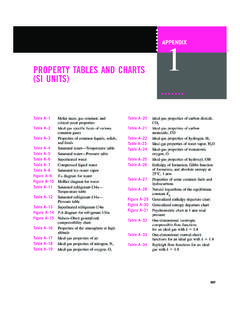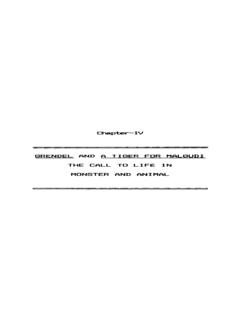Transcription of The Man-eater of Malgudi R. K. Narayan SYNOPSIS
1 Caroline Haley, Post-Colonial Literature, Spring 2015 The Man-eater of Malgudi | R. K. Narayan SYNOPSIS ANALYSIS Originally published in 1961, The Man-eater of Malgudi tells the tale, through the first-person voice, of a printer named Nataraj who lives in the fictional South Indian town of Malgudi . Nataraj lives a quiet and content life until he meets the raucous Vasu, an aspiring taxidermist who disrupts Nataraj s daily printing business, forcibly moves in above the shop, and wrecks havoc around town as he seizes animals through unorthodox measures to populate his demand for exotic stuffed pieces to be shipped to buyers around the world. As Vasu aggressively seeks out exotic animals for his business, he comes across a sacred temple elephant that he is determined to have as a prize for his collection.
2 Nataraj must figure out how to deter Vasu from his mission to shoot the elephant at a sacred festival in town. The Man-eater of Malgudi is one story of several that take place in this town, a backdrop of colonized India with which Narayan was intimately familiar. The story explores multiple relationships, themes, and symbolic elements that collide in conflict over the power of an individual to change the action of someone more powerful than he is. Although Narayan writes with a light tone and comedic prose, Man-eater questions the role of the colonized in accepting the entrance of the colonizing forces. The futility of Nataraj s attempts to confront Vasu, his lifestyle, and his line of work offer a microcosm of the larger issues of colonialism.
3 Nataraj possesses a lot of passion for confronting Vasu, but little idea of what [to] do about it (274). All quotes from: Narayan , R. K. A tiger for Malgudi and The Man-eater of Malgudi . New York: Penguin Books, 2009. Print Theme: Nature While perhaps an obvious element, nature in Man-eater , in the form of Vasu's animals, offers a vulnurability for our sympathies against which we can receive blatant cruelty without any presupposed ties to racial biases. Because of how the townspeople value animals, specifically Kumar the elephant, the role of animals as representative of nature in Man-eater operates to reflect human nature as well "'Anyway, why does he want to shoot the elephant?' I asked. 'He says its more useful '" (274).
4 Theme: Time Time is presented in a distinctly different manner than a Western expectation. Multiple times, Nataraj's daily routine is interrupted by Vasu. Time is also recognized through Vasu's refusal to "waste time" (195), a concept that seems to be foreign to Nataraj. We also witness Nataraj's calm movement through time and how different he marks it. "The signal for me to break off from contemplation was the jingle of ox-bells as country carts forded Nallappa's " (142). Character Profile: Vasu Agressive, overbearing, and selfish, Vasu is presented in direct contrast to Malgudi 's inhabitants. He is deeply unkind and is not given any traits that might suggest he is acting out of a veiled wish to make Malgudi a better or more sophisticated town , as the colonial narrative tends to try and explain.
5 Vasu's motivations are purely financial and in the interest of himself "He might do anything - bellow at me, or laugh scornfully, or rattle my bones"(196). Character Profile: Nataraj Man-eater 's main character, Nataraj gives us a portrait of pre-colonized life that comes into conflict with the interruption of Vasu. Despite a lack of understanding of Vasu's motives, Nataraj remains painfully aware of his subordinate position. This self-knowledge legitimizes Nataraj's character for he can think and act with an agency not often afforded to figures of a colonized nation. "I called pathetically like a child at a fair tugging the sleeve of his elder, 'Vasu!'" (174). Caroline Haley, Post-Colonial Literature, Spring 2015 Further Reading While there does not appear to be a vast selection of criticism written on The Man-eater of Malgudi specifically, Narayan s novels (including this one) do appear in a variety of articles about Indian writing as a whole.
6 The 1960s usher in several pieces exploring what makes the Indian novel unique or important, but by the 1980s, we start to see closer-reads of Narayan s novels themselves, rather than being lumped into an entire genre of work. Based on a brief survey of literary critiques across several databases, current criticism of Narayan s work certainly expanded throughout the 1990s, and the 2000s brought continued critique of Narayan s stylistic choices, specific thematic elements in his work, or other typical points of commentary for most scholars of literature. C. N. Srinath appeared multiple times and seems to be an internationally recognized critic on the works on Narayan as well. Jaqadeswari, C.
7 The Conflict of Good and Evil in R. K. Narayan s The Man-eater of Malgudi . Language in India. (May 2012): 176. Web. Artemis. 7 Feb 2015. Kothandaraman, Bala. The Time Dimensions in R. K. Narayan s Novels. Journal of South Asian Literature. (1987): 28-33. Web. JSTOR. 7 Feb 2015. McArthur, Herbert. In Search of the Indian Novel. The Massachusetts Review. (Summer 1961): 600-613. Web. JSTOR. 7 Feb 2015. Ray, Robert J. A Look at Recent Indian Novels in English. Books Abroad. (Summer 1963): 286-288. Web. JSTOR. 7 Feb 2015. Srinath, C. N. Myth in Contemporary Indian Fiction in English. Indian Literature. (2003): 149-159. Web. JSTOR. 7 Feb 2015.. R. K. Narayan 's Comic Vision: Possibilities and Limitations.
8 World Literature Today. (1981): 416-419. Web. JSTOR. 7 Feb 2015. Author Bio: Although born and died in the same city, Rasipuram Krishnaswami Iyer Narayanaswami was born on October 10th, 1906 in a town named Madras and he died on May 13th, 2001 in that same town, now named Chennai. The span of his lifetime and the shape of his work illustrate the same colonial impact that changed the names of his city, from the British-colonial Madras to India s reclaimed Channai. R. K. Narayan published 15 novels, 6 short-story collections, and multiple other works from mythology to non-fiction. Narayan received the A. C. Benson Medal by the Royal Society of Literature in 1980 and he became an honorary member of the American Academy of Arts and Letters in 1981.
9 Observant, humorous, and prolific, Narayan left a legacy of vibrant and accessible stories that nonetheless reveal a deeply personal pain of man fighting for a well-deserved but long-deprived voice of a colonized people. Image1: R. K. Narayan . 2012. 8 February.



















